

 中文摘要:
中文摘要:
在新疆气候生态条件下,以不同叶型棉花品种为材料,设置不同土壤水分处理,采用人工减源疏库的方法.研究不同土壤水分条件下库源比变化对棉花产量形成的影响。结果表明,中叶型品种新陆早13号在中水(控制0-60cm土壤相对含水量的下限为田间持水量的70%-75%)条件下,叶源轻度胁迫显著增强剩余叶片光合能力.但光合物质累积量及向生殖器官的分配率和单株结铃数、铃重均未发生明显变化,子棉产量与对照无明显差异;鸡脚叶型品种标杂A。在高水(控制0-60cm土壤相对含水量的下限为田间持水量的85%-90%)条件下.库容轻度胁迫后叶片光合速率和光合物质累积量与对照无明显差异,怛光合产物向蕾铃的分配加快.铃重增大,子棉产量有所增加;小叶型品种新陆早10号减源或疏库后子棉产量均显著低于对照。因此,依据不同类型棉花源库关系对土壤水分的响应不同,通过棉田水分管理对源库进行调节,建立合理的库源比,可进一步提高水分利用效率和棉花产量。
 英文摘要:
英文摘要:
Using three different leaf type cotton cultivars, viz. semi-normal leaf, small leaf and okra-leaf, the irrigation experiment was conducted in field. Lower limit of soil relative moisture content in layer of 0-60 cm was controlled at 90%-85% (high wa- ter), 70%-75% (moderate water), 55%-60% (low water) of field capacity, respectively. By means of leaf-cutting and spikelet-thinning treatments to make different sink source ratios, investigated the effects of the altered sink source ratio on cotton yield formation and its response to the different soil moisture contents. The results showed that in the mild defoliation treatment of Xinluzao 13 (semi-normal leaf cultivar) under moderate moisture, the photosynthetic rate of remnant leaves were significantly increased. However, there was no significant difference on the photosynthetic product accumulation and distribution, boll num- bers per plant and boll weight. Consequently, no significant effects were observed on seed cotton yield. In the mild spikelet-thin- ning of Biaoza A~ (okra-leaf hybrid) under high moisture, the photosynthetic rate and accumulation of single plant photosynthate were similar with control, however, it had increased the translocation of photosynthetic products into cotton boll, consequently, the boll weight and yield increased. Whereas, the yield of Xinluzao 10 (small leaf cultivar) was decreased significantly after sourse-sink manipulation. So, we should not only adopt pruning methods, spraying plant growth regulator, fertilization and other measures, but also adopt water management in cotton field to regulate source sink relation of cotton in order to establish a rea- sonable sink/source ratio. It would be beneficial to improve the cotton yield and water use efficiency further.
 同期刊论文项目
同期刊论文项目
 同项目期刊论文
同项目期刊论文
 期刊信息
期刊信息
